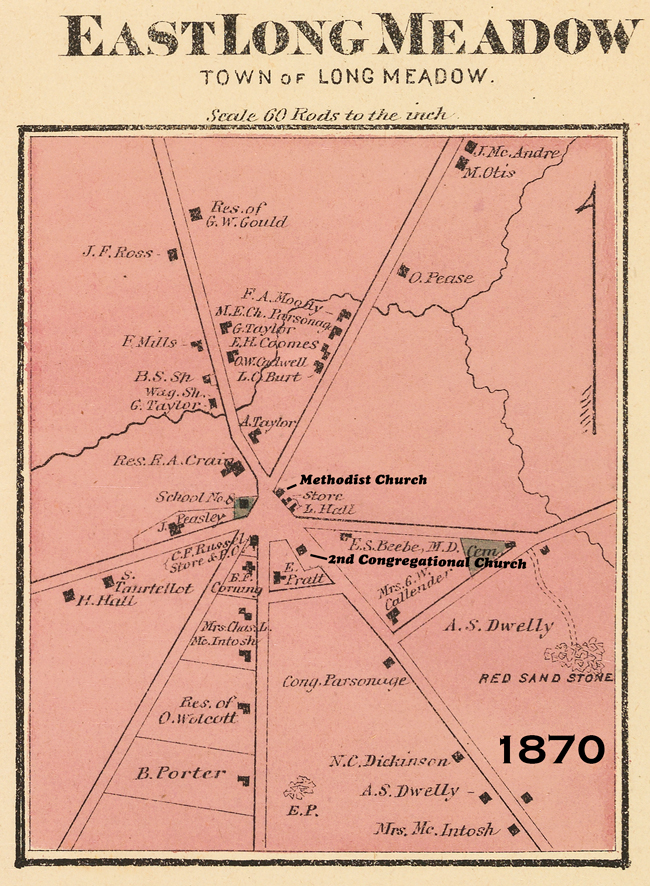|
The East Village of
Longmeadow
East
Longmeadow was settled in the 1740's as a new village
within the Longmeadow precinct of Springfield. The
pattern of settlement-widely scattered farms and
homesteads-reflected the concern of the
pre-Revolutionary period with greater individual
freedom. This major change contrasts with the earlier
emphasis upon Puritan communalism reflected in the side
by side home-lot pattern of the meadows farmers when
they moved up onto the hill in the early 1700's.
Known first as "Inward Commons"
because herdsmen brought their livestock here for
pasture, this section was later named "East Village".
Here the fertile soil lent itself to market gardening,
poultry and dairy farming and the development of apple
orchards, and the outcroppings of brown and red
sand-stone proved a source of ready cash for the small
landowners who quarried it.
The first settlers in the East
Village came from the West Village (Longmeadow Street)
and were of Puritan stock. Jonathan and Elijah, sons of
David Burt, and Silas, son of Thomas Hale, settled here
about 1740. After them came Lathrops, Hancocks, Ashleys,
Hunns, McCregorys, Swetlands, Pratts, Billingses and
others. Roads which bear the names of early settlers
include Cooley, Hall, Markham, Porter, Pease, Crane,
Calkins, Taylor and Dwight.
In the early years, families walked
or went by wagon to the First Church in Longmeadow,
traveling through three and a half miles of wilderness
each way. As part of the Longmeadow precinct and parish
within Springfield, they attended Sunday services and
town meetings there until a Congregational meeting house
was built in the East Village in 1829. This was known as
the Second Congregational Church and Third Religious
Society of Longmeadow.
Town meetings were then held
alternately in East and West Village churches until the
Town Hall in the center of the East Village was
completed in 1882, providing a second floor auditorium
for the gatherings. The structure was of native stone
donated by the Norcross Brownstone Company. The first
town meeting here was held on April 3, 1882.

click
here to enlarge
The Baptist Church, known as the
Second Religious Society of Longmeadow, organized in
1818 and built a meeting house in southeastern Baptist
Village. The Methodists organized in 1853 and
constructed a church in the center of the East Village,
named the "Church of the Seven Roads" because of the
seven main roads converging in the center
For many years, the sandstone of the
East Village was considered public property and any
person had a right to it. But from 1800, the business
was carried on by owners of the land or by quarrying
companies leasing it.
During most of the 1800's there were
50 or more quarries in operation. By 1894 there were 12.
The major ones were the Worcester Quarry which produced
brownstone, the Kibbe Quarry, reddish brownstone, and
the Maynard Quarry, real red sandstone of unequaled
color, texture and durability. These quarries, with
three distinctive shades of stone, were separated by
only a mile.
The stone was removed in huge blocks
of 10 to 20 tons each, then cut and finished before
being shipped to all parts of the country. It was used
on buildings at Wesleyan, Yale, Princeton and other
universities, on Trinity Church in New York City and
many other famous structures.
As the quarrying work grew in scope
and volume, Canadians from New Brunswick and Nova Scotia
began to come to the East Village for the stone-cutting
season, sometimes as many as 50 or 60 on a single train.
(Railroad service for this community was inaugurated in
1876 when the Connecticut Central Railroad was
completed.) Later there was an influx of Swedes, who
settled here and became U.S. citizens, then a few Poles,
then the Italian settlement came into being.
This economic and ethnic diversity of
the East Village both reflected and fostered a growing
divergence of the two villages that made up Longmeadow.
The two villages had been close for a number of years.
Despite the distance between them, they were connected
by intermarriages and indentified in the same precinct
and town and, until 1829, in the same church. However a
gradual separation came about as the population of the
East Village increased and that of the West Village
decreased.
The East Village required more
expenditures and improvements as it had many more miles
of roads, more inhabitants, more schools, more industry
and business, and a busy railroad. Yet the West Village
was paying half the total tax bill.
There was dissatisfaction on both
sides over the valuation for taxation of the stone
quarries and the tenement houses lodging the quarry
workers and their families.
These and other factors led to the
eventual division of Longmeadow into two parts, with
East Longmeadow incorporated as a separate town in 1894.
Jeanne P. Goodlatte
East
Longmeadow Historical Commission
|

